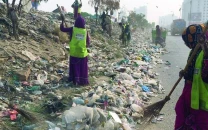PDNA report estimates $16.3b for post-floods reconstruction
Ministers express frustration over negligible world support; lenders want Islamabad to stay on course

Pakistan needed at least $16.3 billion for the post-floods rehabilitation and reconstruction, a new report of Post-Disaster Needs Assessment (PDNA) revealed on Friday.
The PDNA report, released by the representatives of the government and the international development institutions, calculated the cost of floods at $30.1 billion – $14.9 billion in damages and $15.2 billion in losses.
The figure is $2.2 billion less than initially announced by the government at a donors’ roundtable in the US earlier this month. The scope of the report is limited to 94 calamity-hit districts, excluding the areas that were affected by the floods but have not been declared as calamity-hit.
“Pakistan will require a minimum $16.3 billion for rehabilitation and reconstruction, which is based on what the government and the international community can do for the flood affected people due to limited resources,”
Planning Minister Ahsan Iqbal said at the launching ceremony.
The sector that suffered the most damage is housing, sustaining $5.6 billion damages and another $636 million in losses. A $2.8 billion will be required for rehabilitation of this sector.
The agriculture, food, livestock, and fisheries sector also suffered the highest damages and losses to the tune of $13 billion, which include $3.7 billion direct damages. The government will need $4 billion for rehabilitation and reconstruction.
The transport and communication sector sustained a total $3.6 billion in damages and losses and its needs are assessed at $5 billion – the highest requirements by any sector.
Sindh has suffered the most – with $9 billion in damages and another $11.4 billion in losses, bringing the total cost $20.4 billion or 68% of the total cost.
Balochistan sustained $4.1 billion in damages and losses, followed by Khyber-Pakhtunkhwa $1.6 billion and Punjab $1.1 billion.
Pakistan calls out world community
At the ceremony, Ahsan Iqbal and Climate Change Minister Sherry Rehman came hard on the International Monetary Fund (IMF) and the donors community for a lack of support.
Iqbal called out the IMF and criticised it for placing fiscal restrictions on Pakistan despite devastating floods that affected 33 million people.
“The IMF has imposed a condition on Pakistan that it cannot even spend 40% of its own development budget before the last quarter of this fiscal year, which is harsh, unjust and unfair and needs to be immediately reversed”, Iqbal said.
The government had allocated Rs728 billion under the Public Sector Development Programme (PSDP) but Rs291 billion of it can be spent only between April-June 2023 that too if the country is on track to implement the IMF fiscal targets.
“Other countries get relief in debt but we have been asked to make an appeal for humanitarian assistance, which is not the solution,” said Rehman, adding: “We have not been able to serve even half of the affected population.”
The minister added that Pakistan would not go around the world with a begging bowl in its hands. She stressed that the countries should meet their “moral and financial” obligations.
Iqbal said that the affluent nations must sign debt-swap deals with the flood affected countries. “The rich nations must fulfil their commitments to contribute $100 billion per annum towards the poor nations to mitigate climate change losses”, he added.
Finance Minister Ishaq Dar had also not received encouraging response during his recent visit to Washington, as the IMF handed over a list of demands, including imposition of roughly Rs600 billion in new taxes.
“Pakistan is a test case for climate justice … after the launch of the report, the ball is now in the court of G-20 nations”, Iqbal said, adding that Pakistan’s 20 years of poverty reduction had been washed away in just two months of rains.
Rehman said that the world should not “lecture us and instead, help us to reach out” to 33 million flood-affected people.
“It is certainly important that the reconstruction plan should be based on a sustainable financing plan, said Najey Benhussain, the country director of the World Bank.
To a question about an alternate financing plan if the world does not help, Iqbal said that so far Pakistan had met almost all the relief and rescue related requirements from its resources but “we hope that the international community will come up with pledges” at the donors conference.
“They are pledging billions of dollars to Ukraine but are not ready to meet their moral obligations towards Pakistan that is affected by the climate change, caused by the development in the West,” said Iqbal.
The disaster will have a profound impact on lives and livelihoods, according to the PDNA report. Its preliminary estimates suggest that the national poverty rate will increase by 3.7 to 4 percentage points, pushing between 8.4 and 9.1 million people into poverty, as a direct consequence of the floods.
Similarly, multidimensional poverty will increase by 5.9 percentage points, meaning an additional 1.9 million households will be pushed into non-monetary poverty.
Beyond the national average, poverty in Sindh would increase by between 8.9 and 9.7 percentage points, and between 7.5 and 7.7 percentage points in Balochistan. Moreover, the depth and severity of poverty will increase for households that were already poor before the floods.
The poverty gap has substantially increased, with the number of extremely poor people living more than 20% below the poverty line, increasing from 18 to 25-26 million.
In addition, recent gains in infant and maternal health may be reversed, undermining efforts to reduce poverty. There will be an increase in the proportion of households deprived of access to health facilities.
As a result, an additional 5.5 million households with children under 5 will not be fully immunised, leaving children at risk of deadly and preventable diseases. An additional 2.8 million households with new-borns will be deprived of ante-natal check-ups and post-natal care.
The 2022 flooding caused widespread destruction of housing and human settlements. In the 94 calamity-hit districts, approximately 780,000 houses were destroyed and more than 1.27 million houses were partially damaged.
The floods impacted approximately 17,205 public schools. At least 6,225 education institutions were assessed as fully damaged and 10,980 as partially damaged. This has affected some 94,478 teachers and 2.6 million enrolled students.
The 2022 floods affected close to half of the country, damaging 13% of the health facilities, which in turn interrupted health service delivery from the community level.
Malnutrition, which was already dangerously high, has substantially increased.
Around 650,000 pregnant women are facing challenges in getting access to maternal services, while nearly 4 million children lack access to health services.
Do More
Pakistan will have to have enabling policies and institutional arrangements for rehabilitation and reconstruction, according to the report. It added two key steps necessary to achieve the vision and objectives.
Firstly, the notification of enabling recovery policies; and secondly the finalisation of appropriate institutional and implementation arrangements, according to the report.
The appropriate institutional and implementation arrangements should be based on good governance. The arrangements will need to include special provisions for strategic oversight and decision-making; coordination, management, and monitoring of operations; and transparency, accountability, and equity in resource allocation, especially for priority recovery interventions.
“While targeted relief measures are needed to cushion the human and economic impacts of flooding, delays in fiscal consolidation will heighten risks to macroeconomic and fiscal stability in the context of the high inflation and fiscal and current account deficits”, advised the lenders.
Similarly, monetary policy should necessarily be maintained at the current tight stance given the overheating economy, extremely high inflation rates, and exchange rate depreciation pressures, it added.
To manage short-term risks, the government needs to strike a delicate balance between progressing on the required fiscal consolidation and meeting targeted relief and recovery needs.
In the context of high domestic and external financing needs, ongoing political uncertainties, and upcoming elections, maintaining market confidence will be critical.
It will be critical to maintain a tight monetary policy stance; pursue fiscal consolidation to the extent possible, including through the tight targeting and prioritisation of any new expenditures; and proceed with planned structural reforms, including in the energy sector.



















COMMENTS
Comments are moderated and generally will be posted if they are on-topic and not abusive.
For more information, please see our Comments FAQ